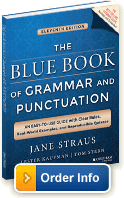|
Welcome to your GrammarBook.com e-newsletter.
|
I purchased The Blue Book of Grammar and Punctuation after finding GrammarBook.com. The book is well loved.
—Emily R.
I am using GrammarBook.com to learn English as my second language. It is extremely helpful. Thank you.
—Trinh N.
As a writer, I've used the
e-newsletters and quizzes to refresh all those lessons I've either forgotten or ignored. It's been a most useful tool.
—Randall P.
|
|
|
Collecting the Truth About Collective Nouns
American English offers us words as tools for efficient and clear
communication. One such tool is the collective noun, a noun that is
singular in form but singular or plural in meaning depending on the
context.
A collective noun represents a group of people, animals, or things.
Examples include:
| band |
flock |
bunch |
| crowd |
herd |
fleet |
| pack |
hive |
pack |
| staff |
litter |
range |
| team |
school |
stack |
These words allow us to suggest the components without having to identify
everyone or everything in the group. This same economy however can raise
questions about how to use collective nouns accurately and consistently.
To help keep our mental muscles strong and flexible for careful writing,
we’ll here brush up on the basics.
Collective Nouns: Subject-Verb Agreement
When we refer to a staff or a bunch, how do we decide on
verb agreement, understanding the noun can be plural or singular?
It depends on whether we want to emphasize the collective noun as a unit or
as an umbrella term for individuals. Compare the following:
Our staff is the most professional you’ll find in the industry.
Our staff are highly competent at their specializations.
The first sentence underscores the group as one unit. The second conveys an
aggregate of different people.
Including a prepositional phrase after the collective-noun subject can help emphasize both the unit and its parts with either a singular or a plural verb depending on the context and intent.
In the following, each collective noun is a singular subject (unit) with a singular verb. The plural object of the prepositional phrase simply adds description and detail:
The crowd of fans is roaring for an encore.
The herd of cows is grazing over there.
The litter of cats is nursing right now.
The same collective nouns with prepositional phrases can be used with a plural verb to create a stronger image of many individual components—i.e., the prepositional phrase becomes an extension of the verb:
The crowd of fans are split between the Yankees and the Red Sox.
The herd of cows are wandering in the pasture.
The litter of cats are competing for space to nurse from the mother.
Note too that collective nouns can be made plural, making verb agreement obvious:
The fleets of ships are heading out to sea.
The stacks of papers you need are on the desk.
Similarly, a collective noun is clearly singular if it is preceded by a singular determiner such as that, a, or the: That band is …, A flock is …, The range is …
For even more insight, review our earlier article Subject and Verb Agreement with Collective Nouns.
Collective Nouns: Consistency
Another factor to watch for when using collective nouns is consistent
usage. Consider the following sentences if they were to appear within the
same paragraph:
The staff is divided into four divisions.
The business’s staff are specialists in their fields.
Our preceding section justifies why one collective noun would use a
singular verb and the other a plural. However, some grammarians and careful
writers would call it bad form and style to switch between the two,
particularly if the sentences are close or, more awkward still, in the same
sentence:
The staff is divided into four divisions, and they are specialists in
their fields.
A better treatment would be:
The staff is divided into four divisions of specialists.
If a collective noun appears on different pages or in separate chapters or
sections, we believe it acceptable to alternate between plural and singular
for desired emphasis.
For even more insight, review our earlier article Collective Nouns and Consistency.
As with any other grammatical principle, the key to using collective nouns
is to ensure they add to crisp, clear, compact sentences. Whenever they
start to disagree with their verbs or become inconsistent, they turn into
obstacles. The careful, attentive writer can always find the right fix to
keep composition flowing and moving.
Because of the e-newsletter’s large readership, please submit your comments or questions regarding today's (or any past) article through GrammarBook.com’s Grammar Blog
|
|
Free BONUS Quiz for You!
[[firstname]], because you are a subscriber to the newsletter, you get access to one of the Subscribers-Only Quizzes. Click here to take a Subject and Verb Agreement with Collective Nouns Quiz and get your scores and explanations instantly!
More Good News for Quiz Subscribers
We are pleased to announce that we have added even more quizzes to help you challenge yourself, your students, and your staff. We added quizzes to existing categories and created some new categories such as “Vocabulary,” “Spelling,” “Confusing Verbs,” “Subjunctive Mood,” “Comprise,” and “Sit vs. Set vs. Sat.”
We reviewed and strengthened every quiz on our website to ensure consistency with the rules and guidelines contained in our eleventh edition of The Blue Book of Grammar and Punctuation.
If you think you have found an error in a quiz, please email us at help@grammarbook.com.

“GrammarBook's subscription quizzes opened a new door for me, a way to see exactly who is doing the work and who isn’t, and it is very convenient for the students.”
“So convenient … hundreds of quizzes in one click.”
[[firstname]], Subscribe to receive hundreds of English usage quizzes not found anywhere else!
- Take the quizzes online or download and copy them.
- Get scored instantly.
- Find explanations for every quiz answer.
- Reproduce the quizzes to your heart’s content.
- EASY to use.
- No software to download.
- No setup time.
- A real person to help you if you have any questions!
Instructors and Employers: we make your life easier!
- Assign quizzes to your students or employees.
- Students log in from anywhere.
- Scores are tallied and compiled for you.
- You decide whether to let students see their own scores and quiz explanations.
- Let GrammarBook.com take the hassle out of teaching English!
“Fun to test my skills!”
“The explanations really help … thanks!”
Your choice: Subscribe at the $29.95 or $99.95 level ($30 off - previously $129.95).
“I download the quizzes for my students who don’t have computer access.”
Subscribe today to receive hundreds of English usage quizzes not found anywhere else!
“Makes learning English FUN!”
 |
Don’t need all the quizzes at once?
You can now purchase the same quizzes individually for ONLY 99¢ each. Purchase yours here. |

Get Yours Today!
Get Amazon’s No. 1 Best-seller in Four Categories!
No. 1 in Grammar
No. 1 in Reading
No. 1 in Lesson Planning
No. 1 in Vocabulary |
The Blue Book of Grammar
and Punctuation
by Jane Straus, Lester Kaufman, and Tom Stern
The Authority on English Grammar!
Eleventh Edition Now Available
Have You Ordered Your Copy Yet?
An indispensable tool for busy professionals, teachers, students, homeschool families, editors, writers, and proofreaders.
Available in print AND as an e-Book! Over 2,000 copies are purchased every month!
Order Your Copy Today!
- Hundreds of Grammar, Punctuation, Capitalization, and Usage Rules
- Real-World Examples
- Spelling / Vocabulary / Confusing Words
- Quizzes with Answers
The publisher of The Blue Book, Jossey-Bass, A Wiley brand, is offering a 35 percent discount for those of you who order the book through Wiley.com. Shipping and tax are not included. Simply go to bit.ly/1996hkA and use discount code E9X4A.
*Offer expires December 31, 2017.
|
Wordplay

Learn all about who and whom, affect and effect, subjects and verbs, adjectives and adverbs, commas, semicolons, quotation marks, and much more by just sitting back and enjoying these easy-to-follow lessons. Tell your colleagues (and boss), children, teachers, and friends. Click here to watch. |






